Choosing Bathroom Countertops & Vanity Tops
Bathroom countertops are just as important as their brethren in the kitchen because they not only provide a functional work surface but a big piece of the decorating theme as well. A good bathroom countertop is the right blend of aesthetics and durability that's sufficient to meet the demands of how you live.
Vanity tops (we'll use bathroom countertops and vanity tops to mean the same throughout this article) aren't immune from a harsh environment either, particularly in a full bathroom with a shower and/or tub.
First, there's the moisture to contend with that's generated from showers. Then there's all the stuff that's normally found in a bathroom environment like toiletries and cleaning supplies.
When you think about all the challenges that you'll throw at your countertops it's easy to understand that not only should they be beautiful, but durable too.
There are lots of materials to choose from and the first step toward making the right decision is to stop and plan how you'll use your bathroom. From there it's a matter of finding the right combination of material, style and budget. Choose wisely and you'll be rewarded with a countertop that gives you good service for many years.
What You Should Consider Before Choosing
The first impulse when choosing a bathroom countertop is to get something that looks good. And that's ok because as was mentioned earlier, they play a big role in the overall look and feel of the space.
But looks aren't the whole picture because your countertops also serve a functional role. That's why it's important to stop and think about a few things other than how snazzy a particular vanity top looks.
Consider Your Lifestyle
The first step in any decision should be to think about how your use your bathroom on a daily basis and whether that will change in the near future. This will help you narrow down your choices to the ones that will make the most sense.For example, consider the following questions:
- What kind of bathroom are you planning -- a low-use powder room, one for everyday family use or an over-the-top master bath?
A powder room usually doesn't experience the same kind of mess that a full bathroom does. Just think about all the substances that you and your family use there. You have the toothpaste, blemish creams, makeup, hairspray and a host of other personal care items that'll be splashed across your countertop. And don't forget those syrupy, sticky red and purple children's medicines. Think how a limestone vanity top would stand up to that. Bottom line -- a good countertop choice is one that's compatible with how the room is used. - How many people will typically use the bathroom on a daily basis? Does that include children?
More traffic and users means more mess. Small children all the way up to teenagers can be tough on a bathroom (since they usually don't have to clean it...). Choosing a durable, easily-maintained surface is a good choice in these situations. - Does your plan call for a larger custom-installed countertop or do you just need a top for a smaller vanity?
Vanity tops (for stand-alone vanities) are widely available online and at home improvement centers in a variety of sizes. Custom bath countertops installed over cabinets will need to be installed by a fabricator/installer. You'll pay more for custom counters and the process of getting them is more involved than for a vanity. - How long are you planning on staying in your home? In other words, is this upgrade for you or for your home's next buyer?
If it's for you then don't be too hesitant to splurge or go with what you really want. If you're upgrading to sell your home, get something that looks good but with practicality in mind too. - Do you want a countertop that's made from environmentally-concious methods and materials?
Choose one of the recycled-content surfaces made from used paper or glass. It's an easy way to add some "green" to your bath design.
Answering these kinds of question ahead of time can help you narrow down the materials that work best for your situation.
Bathrooms with a lot of traffic or families with children usually means the sink and countertop need cleaning more often. Easily-cleaned and less 'delicate' surfaces make sense in these situations.
A bathroom that will be your sanctuary after a hard day's work might be best outfitted with a custom-designed concrete or glass countertop, just because it makes the space feel a bit more indulgent (practicality doesn't always have to rule).
Photo Courtesy of the Slab Lab Concrete Studio
A Few More Points To Consider...
And speaking of practicality, here are a few more considerations to think about before you lock in your decision:- Don't Forget The Sink
The type of sink you want or more specifically, how it's installed, also impacts your countertop decision. If you like the look and easy-to-clean nature of an integral sink then solid surface, concrete and glass countertops are your leading contenders. You'll also need to know this so that your countertops are fabricated correctly, with consideration for whether your sink will be a drop-in, undermount or vessel style. - A Good Plan Helps
There's no rule against choosing a particular type of countertop before your plans are finalized, but having a plan in hand ahead of time is advantageous. When you have a plan you know how much counter space you need, which will help you compare costs among the various options. A fabricator is eventually going to need these dimensions anyway. Even if you're only looking for a pre-fab vanity top you'll still need to know the size of the vanity for your new or remodeled bathroom.
A Word About Vanity Tops
From a functional point of view vanity tops and bathroom countertops are essentially one in the same. They perform the same role and are made from the same materials. The only way they differ is in how you buy them and the amount of style options that are available.Vanity tops are a classification of bath countertops that are pre-made. In other words, you don't need a fabricator to come into your home, measure your space and custom-fabricate and install your countertop surface. Instead, you can buy vanity tops at home centers and online that will fit various sizes of vanities. For the most part they're made from the same materials as custom countertops. You just won't have the same breadth of style choices that you do with a custom installation.
The up-side of vanity tops is that they're easy to get and install. Some vanities come with a top already included or you can buy just the vanity and shop for the top separately. You can also change the top on an existing vanity.
The point to remember is that it doesn't matter whether you're choosing a simple vanity top or a larger bathroom countertop. The range of material choices are similar and what you choose should be compatible with how you'll use it.
Bathroom Countertop Choices & Their Pros & Cons
There's no shortage of countertop materials and your biggest hurdle will probably be narrowing your choice down to just one. You obviously want to get something that looks good but just remember that there are other considerations to think about like ease of maintenance and durability.
To get you started, here's a list of choices along with their good and not-so-good qualities.
(Note - in most sections below there are links like "Laminate Countertops" that will take you to a more detailed article about that kind of countertop material).
Laminate

Laminate countertops work well in the bathroom because they're durable, moisture-resistant and they're offered in more colors and styles than you can shake a hairbrush at. Plus, laminate's affordable. Laminate is, for lack of a better descriptor, a thin plastic sheet that's made up of a number of layers of material with the decorative (color/pattern) layer just underneath a transparent wear-resistant coating. The laminate sheet is glued to a substrate material like plywood, particle board or medium density fiberboard (MDF). Laminate is non-porous which helps it resist staining and makes it easy to clean and maintain.
| Pros | Cons |
|
Very affordable, arguably the most economical choice Lots of prefab vanity & pre-made countertops available Very wide range of patterns and colors available Easy to clean; a low-maintenance surface |
Not immune to edge-chipping and scratches Not as repairable as other types of ctop materials Dark-edge seams are visible depending on the type of installation Long term exposure to high humidity and moisture may cause the material to peel or come unglued (delaminate) from the substrate beneath it (depending on the quality of the bond) |
Solid Surface & Cultured Marble/Granite/Onyx
Solid surface is a form of plastic and makes a good bath countertop because like laminate, it's impervious to moisture and easy to keep clean. The other benefit is that you can get an integral solid surface sink so there's no seam or delineation between the edges of the countertop and the sink. There are lots of prefabricated solid surface vanity tops available in the marketplace which makes it convenient for DIY'ers.
Cultured marble and it's close siblings cultured onyx and cultured granite are similar to solid surface in that they're a combination of fillers and resins. However they differ from solid surface in that they're coated with a material called "gelcoat". This coating provides the base material with a hard, non-porous and shiny protective surface. Cultured marble is used a lot in pre-fab vanity tops although it is available for custom installations by certain fabricators.
| Pros | Cons |
|
Non-porous surface that's easy to clean and maintain Solid surface and cultured marble are renewable - scratches can be polished out Available in pre-made vanity top styles Allows for a seamless integral bathroom sink Lots of colors and patterns available |
Custom installations of solid surface require professional fabrication These materials are softer than other types of surfacing and can scratch more easily - you don't want to use abrasive cleaners particularly on surfaces with a high sheen Both solid surface and cultured marble aren't heat tolerant (however things like hot pans aren't usually found in the bathroom) |
Natural Stone
Natural stone countertops offer beauty and durability but the key here is to choose the right stone for your particular bathroom's environment. The bathroom is actually a better location for a marble countertop than the kitchen because the bathroom doesn't see the same "challenges" as a kitchen does with respect to foods and other substances that can damage that kind of stone. The point to remember is that some stones (more porous and/or calcite-based) need more care and maintenance than other types of stone and other vanity top materials.
| Pros | Cons |
|
Offers a natural beauty that's hard to duplicate Stone is durable and won't easily scratch or mar, particularly in a bathroom environment The right type of stone (such as dense granites and soapstone) are virtually non-porous and easy to maintain from a stain-prevention perspective Pre-fabricated stone vanity tops are readily available for various vanity sizes |
Some stones (unless very dense) are porous and need to be sealed for stain protection Stones that are calcite-based (like marble) don't get along well with acidic substances so certain cleaners need to be avoided with more sensitive stones Can be more expensive than other surfaces depending on the type of stone used (color, rarity, availability) and whether it's a custom fabrication/installation or a pre-fab top Pre-fab stone vanity tops are usually offered only in a limited range of colors/types of stone |
Engineered Stone/Quartz
Engineered stone is a hard surface that's a marriage of crushed stone/minerals and resins, compressed into into sheets under high pressure. One of the major players in this category is quartz surfacing. The benefit of engineered stone is that it's non-absorbent (unlike some natural stone) so it doesn't require any sealing or ongoing maintenance. There are plenty of colors and patterns available too, many that mimic the look of natural stone.
| Pros | Cons |
|
Hard and durable like stone but without the porosity and need for sealing Styles are available that mimic the look of real stone Wide range of colors/patterns including 'non-earth tone' colors like bright red and blue and many shades in between Available in pre-made vanity top configurations |
Can be damaged by highly alkaline or acidic chemicals like drain-clog dissolvers as well as solvents, bleach and abrasive cleansers (the latter can dull the shiny surface) More expensive than other varieties of bathroom countertops Requires professional installation for situations that aren't covered by a pre-fab vanity top |
Concrete
Photo Courtesy of Andrew Hovde / Hovde Design
Concrete countertops provide a unique and attractive option that offers a lot of room for creativity. They're usually custom fabricated to fit your vanity or bathroom space and can be made using any color you choose. Since concrete is naturally porous it requires sealing and periodic upkeep to maintain it's integrity. You can have an integral sink with a concrete bathroom countertop or use it as a conventional countertop with other types of sink installations (undermount, drop-in or vessel).
| Pros | Cons |
|
Unique and attractive appearance Highly customizable Can incorporate an integral sink as well as decorative items inlaid into the concrete surface |
Usually requires professional fabrication & installation though there are shops that can make a vanity countertop for you that you can install Can be chipped and may form hairline cracks Requires sealing to protect against moisture and stains Heavy - requires sufficient support from vanity/base cabinets |
Recycled & Composite
Photo Courtesy of Glass Recycled
Composite and recycled counters are made from recycled and re-used materials like glass and paper that are combined with resins or some form of cement. The materials are amalgamated into sheets and slabs that can then be cut and shaped. The result is a surface that's smooth, hard and attractive and offers a way to bring some eco-friendly elements into your bathroom. The range of material types in this category varies from resin-based products that are like solid surface to cement-based materials that are more similar to concrete, with similar pro/con qualities.
| Pros | Cons |
|
Hard, durable surface "Green" material due to recycled content and/or eco-friendly fabrication methods Similar positive qualities as solid surface or engineered stone depending on the specific product you choose (for example, paper-based or recycled glass products) Recycled glass countertops are offered in a wide range of color selections and custom colors are available from some fabricators |
Availability may be limited depending on the specific material you choose Some cement-based composite materials need to be sealed Long-term durability is still unknown based on newness of some materials within the marketplace |
Tile
Ceramic, porcelain and stone tile is another option and the ceramic and porcelain tiles can usually stand up to just about anything that's thrown thrown their way. However a tiled bathroom countertop means you'll have grout lines that can be hard to clean. A tile counter can also contribute to 'tile overload' if you have tile in other areas of your bathroom. And don't forget that real stone tile will probably need to be sealed depending on the type of stone the tile is made from (see the 'stone' pros/cons above).
| Pros | Cons |
|
Ceramic/porcelain tiles are very compatible with the moist bathroom environment Wide variety of styles and colors to choose from Affordable depending on the tile you choose |
Stone tiles may require sealing like their monolithic countertop cousins Grout can discolor and stain over time and requires sealing Grout lines make it harder to clean and maintain the surface (it's harder to just "swipe clean" because the grout lines interrupt the smooth surface) |
Glass
Glass makes for a durable, stylish and easy-to-clean surface. Glass countertops are non-porous so there's no need to seal them. They're available in many forms and colors and can be customized too. Styles range from slim sheets to thicker monolithic slabs. Glass may not be the first material you think of for a countertop material but it's one that has a lot to offer.
| Pros | Cons |
|
Non-porous and easy to clean and maintain Not sensitive to chemicals like other surfaces - regular glass cleaner or vinegar and water will usually suffice for cleaning Unique choice for a countertop material Can be customized with tints and texturing Can be made with integral sinks Available in pre-fabricated vanity tops or custom-made with a variety of colors and textures |
Can be more expensive than other countertops depending on style and customization Glass doesn't hide fingerprints and general bathroom "rash" (spilled toothpaste, etc.) very well because the dirt mars the otherwise clear surface (think about how a dirty mirror looks) unless the glass is textured in some way Although the glass is typically durable chips and cracks are a potential hazard and are non-repairable |
Any Other Options?
The materials listed above are those that, more or less, have "established" themselves as viable work surfaces for the bathroom environment. However you might ask, "are there any other alternatives?"There are some other types of materials that can be used and are used for kitchen countertops. But that doesn't mean they're suitable for the bathroom.
- Wood
Wood countertops are beautiful and they're available in a wide range of styles, species and colors. Wood expands and contracts however and with the amount of moisture that's typically present in the bathroom, particularly one with a steam shower, wood should probably not be at the top of your list. Keeping it clean amidst the onslaught of all the substances you find in a busy bathroom would also be a challenge. - Metal
Metal countertops are another option and offer a different style and look compared with the regular standby countertop materials. But again, you have moisture and cleaning chemicals to contend with that could impact the long term look and viability of a metal countertop.
These types of surfaces may be okay in a powder room that has no bathtub or shower which produces high humidity. Often a powder room isn't subjected to the same scope of toiletries that you find in a full bathroom either, so the potential for getting messy is limited.
If that's the case then these other types of surfaces might work as a bathroom countertop. Be forewarned however and don't be surprised if these materials cause you some grief later on.
Finding Local Installers & Getting Free Quotes
If you're looking for a small bathroom vanity top that you can install yourself, you're in luck. You can find these products in home centers and online and they're not too difficult to install.
However if you need help with a larger bathroom countertop job and are looking for local sources, perhaps the form below can help. It provides a means to have local installers contact you at your convenience. The benefit is obviously not having to cold-call to find a contractor but they can also provide a free estimate for your particular job. That way it gives you leads for eligible contractors and an idea on how much your particular project might cost.
Simply fill in the form below to start the process of finding sources in your area.

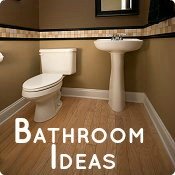
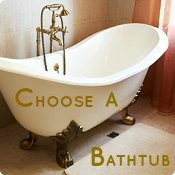
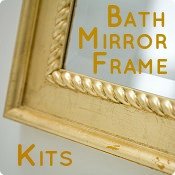
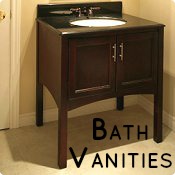
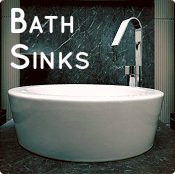
Publisher's Comments --
So What's The Best Bathroom Countertop?
This question pops up now and then and when you get right down to it, it's one we all have when it comes to choosing a product for our home. I could cop out and answer by just saying "whatever bathroom countertop works best for you", but you'd probably hurl virtual tomatoes at me.
Instead I'll give you my best shot at what I personally think are good choices for a bathroom or vanity top. But before I open the envelope, some qualifiers are in order:
Style Is Good But Functionality Is Even Better
I put a lot of stock in considering how you actually live and use the bathroom when making a choice like this. My main upstairs bathroom is shared by 3 boys and as they've grown from toddlers to teenagers, let's just say that their tidy-ness is still a challenge. Toothpaste, spilled soap, hair glue and the like constantly barrage our existing countertop -- which happens to be tile by the way.
A particular type of countertop might look great but if it's not easy to clean and maintain, it's not a big contender in my book. And I must say, I'll never have another tile countertop, bathroom or kitchen, in my house again. The tile cleans well enough but the grout lines and uneven surface are a headache.
So when it comes time to renovate that bathroom, here are my top picks at the choices. My qualifications include a blend of good looks, low-maintenance and wide availability.
There are plenty of colors and styles that are available, some that look like marble and other types of natural stone (which is one of my favorite materials by the way). The fact that it's non-porous and easy to clean in combination with good looks is a winner for me. It's also compatible with any type of sink installation.
I also have to say that the quantity of colors and styles have just continued to get better. Several makers of quartz surfacing have done a great job at mimicking the veined, marbled look of natural stone. There are some terrific light-colored quartz products out there that look very much like marble. You just don't have the worries that come along with those kinds of natural stones.
If this type of surface has an Achilles heel it's the fact that it can be sensitive to some of the stronger chemicals. However I think it's still a good contender.
In this particular case I'd go with a solid-color solid surface. Darker colors might show scratches a bit more than lighter colors. The easily-to-clean surface and integral sink option makes it a good choice for ease of maintenance. You also don't have to worry about the issue of hot pans coming in contact with the surface, like you do in the kitchen. I don't think there are any curling irons that get as hot as a frying pan right off the burner.
Cultured marble is a similar alternative unless you're not keen on the highly polished gelcoat surface.
If you're looking for something extremely practical as well as economical, then a laminate surface makes the short list. It's not my first style choice because in my opinion it falls short in the looks department. But it's a tried-and-true countertop material and when you need something that's economical and low-maintenance, laminate is hard to beat.
So there you have it; the best bathroom countertop surfaces, in my humble opinion. They're attractive, easy to maintain and readily available, whether it's for a custom installation or a pre-fab vanity top. They strike the right balance between the function they need to fulfill and the style they bring to the table.